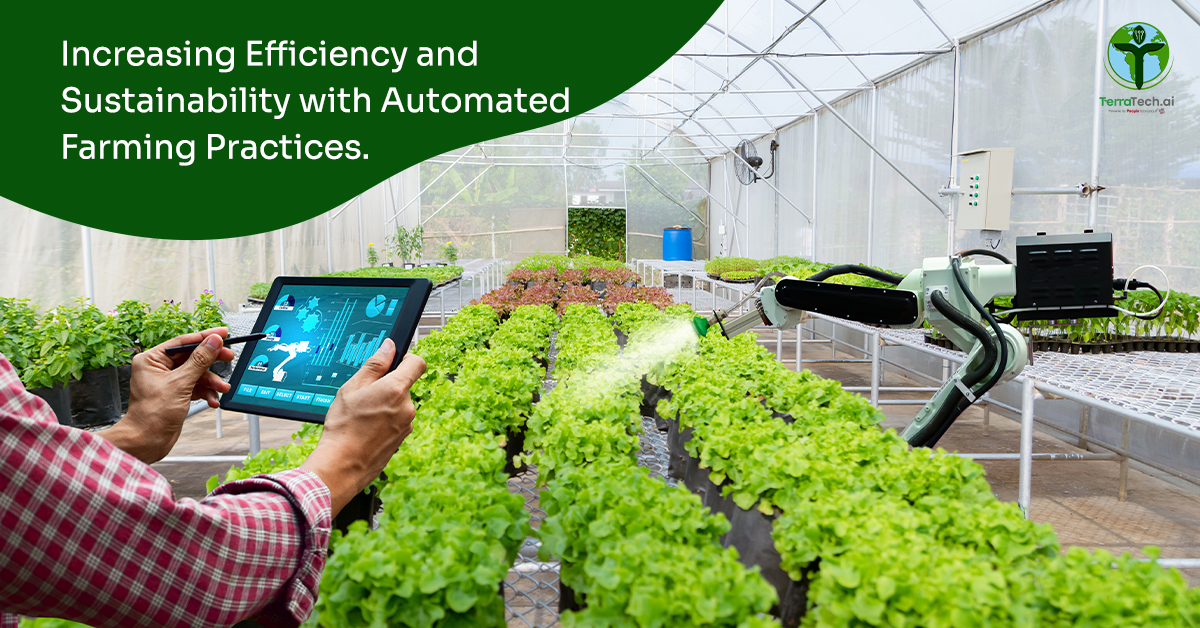Increasing Efficiency and Sustainability with Automated Farming Practices
Introduction
The invention of agriculture offered a sense of stability to humankind. Agriculture fostered the relationship between humans and the environment. It utilized man’s engineering abilities to produce food from environmental resources. It led to further inventions such as crops, fire, and modern machinery. Long story short, agriculture is the basis of human existence and survival.
The recent report indicates the need for a 70% increase in agricultural production to sustain the global population projection of 9.7 billion people by 2050. The increasing pressure on the agriculture industry is affecting the health of our planet Earth. In this context, technological advancements in agriculture are seen as means to suffice the growing global food production demands.
Automated farming
Automated farming, or smart farming, utilizes various technologies to automate agriculture operations, reduce costs, improve agricultural efficiency, promote sustainability, and address labor shortages. Technological advancements such as AI (Artificial Intelligence), robotics, and sensor technology make automation more viable and affordable.
Automated farming technologies
As the global market for farm automation is expected to expand in the near future, AgriTech companies developing and selling farm automation technologies will be in huge demand. The main objective of AgriTech companies is to employ smart technologies to execute mundane and extensive tasks. It includes robotic farming technology, automated irrigation systems, autonomous farming equipment, etc.
Below are some of the automated farming technologies:
1. Harvest Automation
It has been found that harvesting fruits and vegetables is tough using agriculture automation as robots may not handle crops gently, ending up with bruising and damage.
However, some AgriTech companies are developing robots that can harvest crops gently. The development of such robotic systems revolutionizes the agriculture industry.
2. Seeding and Weeding
Automation is transforming the tasks associated with seeding and weeding. For example, robotics reduces extensive labor work in seeding, whereas robotics utilizes computer vision to minimize pesticide usage by 90%.
3. Automated irrigation systems
Automated irrigation systems utilize sensors, controllers, sprinklers, and valves to automate irrigation processes. These systems analyze factors such as soil moisture levels, plant requirements, weather conditions, etc., to ensure the optimal amount of water supply at the right time.
How do these systems work? So, sensors monitor the moisture level present in the soil and send a signal to the controller, which activates the valve according to data interpretation. The valve controls the water flow from the source to the sprinklers. In this way, they conserve water by supplying precise water and improving overall efficiency.
4. Autonomous drones
Agricultural drones employ imagery and infrared analysis to monitor farms, identify problem areas to help farmers take preventive measures, apply fertilizers and pesticides etc.
Drone technology positively impacts the agriculture field by offering several benefits and capabilities. Following are some of the ways by which drones bring change in regular agri practices:
- Bring efficiency to irrigation and fertilization practices
Drones carry cameras and sensors that can capture high-resolution aerial images of fields. These images educate farmers in monitoring crop health, if there are any nutrient deficiencies, detecting pests or diseases etc. With all these inputs at hand, farmers can make informed decisions concerning irrigation and fertilization and achieve efficiency.
- Enable the precise application of resources to reduce waste
Analyzing data collected from drones allows farmers to understand the requirement of resources precisely. Moreover, farmers can implement site-specific treatment to reduce any wastage. Drones allow farmers to practice precision agriculture to optimize crop yields.
TerraTech.AI, a novel AgriTech platform, leverages drone technology to help farmers maximize farming efficiency.
Increasing efficiency and sustainability with automated farming: Advantages
Automated farming is monumental for more than one reason. It contributes to meeting rising global demand for food, mitigates the challenges of labor shortages, and provides efficiency to many farming operations. Below are some of the advantages of automated farming:
1. Meet consumer preferences
With the rise in junk food culture, consumers are inclined towards organic and sustainable food products. Automated farming boosts the productivity of various farming operations, facilitating fresh and quicker produce delivery. Moreover, it increases the rate of production, reducing customer costs.
2. Maximize labor efficiency
Labour shortages are a real problem. Also, labor costs 50% of the cost of growing farms. Thus, 31% of farmers are transitioning to less laborious crops. In such a scenario, harvest machine learning offers vast advantages.
Automated farming technology, like robotics, automates routine tasks while minimizing labor costs.
3. Make farming sustainable
Automated farming contributes to sustainable farming practices. For example, precision farming techniques involve utilizing a precise number of resources for farming, reducing chemical usage etc.
Shortcomings of automated farming
Below are some of the shortcomings of automated farming:
- High costs incurred to employ robotic technologies are a significant concern, especially for farmers in developing countries.
- Technical issues can cost high repair charges.
- Farmers can find it challenging to get accustomed to advanced technologies. They must combine their experience with new knowledge to leverage farm automation.
Way forward
Although the adoption of automation in farming is in its nascent stage, it will revolutionize the agriculture industry in the near future. What we perceive as cutting-edge today will soon become standard and within reach of farmers.
Automated farming makes farming a profitable enterprise. At the same time, it promotes sustainability. The human aspect is at the core of farming. However, automated agriculture is a promising advancement that we must recognize.

